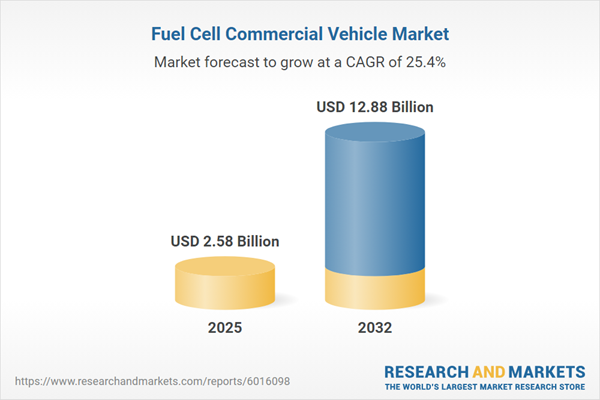Speak directly to the analyst to clarify any post sales queries you may have.
The fuel cell commercial vehicle market is entering a pivotal phase as businesses accelerate the shift towards low-emission transport. Senior decision-makers face increasing expectations to implement sustainable mobility while navigating evolving regulations and complex supply chains.
Market Snapshot: Fuel Cell Commercial Vehicle Market Trends and Growth
In 2024, the fuel cell commercial vehicle market is valued at USD 2.10 billion and is anticipated to reach USD 12.88 billion by 2032, advancing at a compound annual growth rate (CAGR) of 25.43%. This progression reflects strong momentum from global investment, increasing adoption of zero-emission transport, and expanded hydrogen infrastructure. Collaboration across technology providers and regulatory support are accelerating commercialization, allowing diverse regions to adapt business models for hydrogen-enabled fleet deployment and strategic scale-up.
Scope & Segmentation of the Fuel Cell Commercial Vehicle Market
This executive market report delivers a comprehensive assessment designed to help organizations navigate changing industry demands and capitalize on growth opportunities within the fuel cell commercial vehicle market:
- Technology Types: Alkaline, molten carbonate, phosphoric acid, proton exchange membrane, and solid oxide fuel cells—each suited to different operational intensities and lifecycles for a wide range of commercial fleets.
- Power Output Levels: Options below 100 kW, between 100–200 kW, and above 200 kW provide flexibility for light, medium, and heavy-duty fleets, optimizing fleet performance by operational profile.
- Component Categories: Full architecture coverage including bipolar plate-equipped fuel cell stacks, gas diffusion layers, purifiers, reformers, converters, and inverters for complete commercial vehicle integration.
- Vehicle Types: Heavy-duty vehicles like trucks and buses, light commercial vehicles including pickups and cargo vans, and passenger cars such as SUVs and compacts—enabling organizations to align fleet composition with sector priorities.
- Applications: Applications encompass construction, mining, logistics, delivery services, municipal and emergency response fleets, and public sector transport, demonstrating adaptability for both high-utilization and specialty uses.
- Regional Coverage: In-depth analysis by North America, Latin America, Europe, Middle East, Africa, and Asia-Pacific. Country-level perspectives on China, Japan, South Korea, India, Australia, and ASEAN outline regulatory landscapes and market entry requirements.
- Key Companies: Company insights include Ashok Leyland Limited, Ballard Power Systems Inc., Bosch Group, Cummins Inc., Daimler Truck AG, Hyundai Motor Company, Toyota Motor Corporation, and other significant participants—enabling benchmarking and peer evaluation.
Key Takeaways for Senior Decision-Makers
- Proton exchange membrane and solid oxide fuel cells demonstrate high reliability, making them optimal for commercial deployments where operational continuity is vital.
- Collaboration between original equipment manufacturers, technology developers, and energy suppliers is stimulated by evolving policy frameworks, supporting cross-industry advancement and de-risking investment.
- Localizing manufacturing close to core demand centers helps minimize supply chain exposures and allows for adaptation to shifting regulatory or logistics scenarios.
- Standardized hydrogen refueling solutions reduce complexity and cost for mixed fleets and facilitate easier expansion into new markets or regions.
- Asia-Pacific is seeing faster regulatory harmonization, while North America and Europe emphasize strong public-private partnerships and cross-border collaboration for technology integration.
- Sector versatility allows fuel cell commercial vehicles to serve diverse operational settings, supporting both strategic core logistics and niche, high-demand applications.
Tariff Impact on the Fuel Cell Commercial Vehicle Market
Changing tariff environments for imported fuel cell vehicle components are prompting manufacturers to reorient global sourcing strategies. With a trend toward regional production facilities near main markets, organizations gain both stronger domestic supply chains and lower vulnerability to external disruptions. This evolution can affect cost structures, but it enhances resilience and ensures steadier access for fleet operators navigating dynamic international trade conditions.
Methodology & Data Sources
This report is grounded in direct interviews with industry leaders, review of peer-reviewed research, and triangulation with market guidance from leading organizations. Trade and supply chain data reinforce credibility, ensuring suitability for high-level strategic planning and market-entry assessments.
Why This Fuel Cell Commercial Vehicle Market Report Matters
- Enables alignment of enterprise plans with the latest technological shifts and regional policy evolution in hydrogen-powered commercial vehicles.
- Supports informed investment, risk management, and diversification by mapping regional competitiveness and regulatory trends.
- Helps organizations adapt supplier relationships and operational models to maintain market relevance amid changing trade and infrastructure landscapes.
Conclusion
Fuel cell commercial vehicles provide a practical framework for organizations seeking to integrate sustainable transport. Executives who monitor trends and act ahead of the industry will support their organizations in building resiliency and long-term value in a rapidly advancing sector.
Additional Product Information:
- Purchase of this report includes 1 year online access with quarterly updates.
- This report can be updated on request. Please contact our Customer Experience team using the Ask a Question widget on our website.
Table of Contents
3. Executive Summary
4. Market Overview
7. Cumulative Impact of Artificial Intelligence 2025
Companies Mentioned
The companies profiled in this Fuel Cell Commercial Vehicle market report include:- Ashok Leyland Limited
- AVL List GmbH
- Ballard Power Systems Inc.
- Bosch Group
- Ceres Power Holdings plc
- Cummins Inc.
- Daimler Truck AG
- Doosan Fuel Cell Co., Ltd.
- ElringKlinger Group
- FEV Group GmbH
- General Motors Company
- Hyundai Motor Company
- Hyzon Motors Inc.
- ITM Power Plc
- NEL ASA
- Nikola Corporation
- Plug Power Inc.
- PowerCell Sweden AB
- Proton Motor Fuel Cell GmbH
- Scania AB by Volkswagen Group
- Tata Motors Limited
- Toyota Motor Corporation
- Volvo Group
- Weichai Power Co., Ltd.
Table Information
| Report Attribute | Details |
|---|---|
| No. of Pages | 182 |
| Published | November 2025 |
| Forecast Period | 2025 - 2032 |
| Estimated Market Value ( USD | $ 2.58 Billion |
| Forecasted Market Value ( USD | $ 12.88 Billion |
| Compound Annual Growth Rate | 25.4% |
| Regions Covered | Global |
| No. of Companies Mentioned | 25 |









